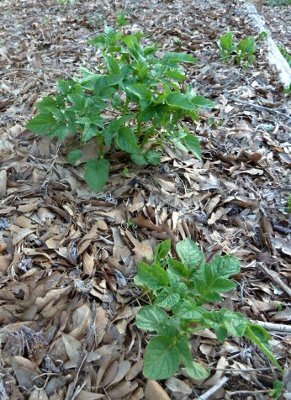Acquiring this book was one of those "one thing leads to another," events. It started with the
Kinder Goat Group message board, which led me to purchase
Pat Coleby's Natural Goat Care. In reading it, I learned she is an advocate of remineralizing one's soil, and she frequently referenced a man named Neal Kinsey in that regard. While visiting
her publisher's website I discovered that he also had written a book,
Hands-On Agronomy: Understanding Soil Fertility & Fertilizer (co-written with Charles Walters). While doing a little online book price comparison, I discovered that Mr. Kinsey also has a
soil testing service. I immediately ordered the book and a soil test. (I'll share about that after I get the results).
The timing for this purchase was absolutely providential. One of
our 2012 goals is
pasture improvement and I was puzzling over how to substitute organic fertilizers for the chemicals recommended by the state cooperative extension service. A Kinsey soil test will tell me how to do that, and not just for nitrogen, phosphorous, potassium, and pH, but also for the various other minerals that are necessary as well.
Right off the bat I can tell you two things about this book. Firstly is that it is truly written for the layman. Secondly, is that I don't immediately understand everything he is saying. Not because it isn't written well, but because this is an area in which I have little knowledge and experience. For me, it's not a read and think "oh yeah, I get that." It's material that I have to read carefully and ponder because it digs deeper (hmm, is that a pun?) than any organic gardening book I've read so far. Perhaps I could say that it gets to the root of soil and hence plant health (yeah, I know :) more so than any other book I've read. In addition, it's written with examples for many soil types and problems, some of which don't apply to me.
Even though I don't have a full grasp on the material yet, there are two themes that are sticking in my head.
- feed the soil and let the soil feed the plant
- soil nutrients must be in balance
Feeding the plant focuses on a specific deficiency. When my broccoli leaves turned purple, I sprinkled the soil with bone meal to correct the problem. I assumed my soil is deficient in phosphorous, so that's what I addressed. I say assumed, because I could have a phosphate deficiency, but I could also have adequate phosphorous that simply can't be utilized by the plant. Phosphorous availability is effected by pH, the clay in the soil, the time and method of application, aeration, compaction, and moisture. Also, it is effected by the amounts of the other soil nutrients. That's where nutrient balance comes in. Too much phosphorous could render my soil just as unproductive as not enough. The bottom line is that if I do what it takes to make my soil healthy, it follows that what I grow will be healthy as well.
If what I grow is healthy, then everything that eats it will be healthier too. Rather than having to supplement my goat feed with vitamins and a mineral mix, they should be able to get most of the minerals they need directly from what they eat. The same is true for us too. That's why this is so important to me.
While I wait for my Kinsey soil test results, I'm giving the book a first go through. When my results arrive, I will be able to re-read with those in hand, and walk away with what applies to me and our soil. Even though we are anxious to get that
pasture established, we want to do it right. Hopefully I'll have an update on that soon.

















































